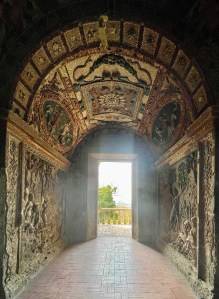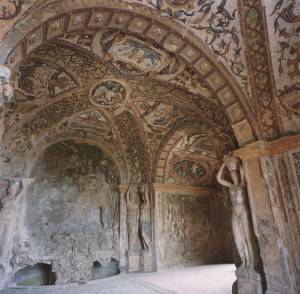MILAN — Fendi has pledged to help conservatively restore the Grotto of Diana at the Estense Garden in Tivoli, working with Villa Adriana and Villa d’Este.
“It is an honor for Fendi to extend its Roman borders to Villa D’Este in Tivoli, acknowledged worldwide as a UNESCO World Heritage Site [since 2001], an iconic place that represents a masterpiece of the Italian-style garden with a vast concentration of fountains and water features, an element strongly celebrated by Fendi,” said Serge Brunschwig, chairman and chief executive officer of Fendi. “This initiative renews our commitment in protecting and enhancing Italian cultural heritage, which in the past has led us to the restoration of symbolic places in Rome to preserve beauty for future generations.”
Tivoli is a 50-minute drive from Rome, which is home to Fendi’s headquarters. The works will begin in the coming months aiming to also improve motor accessibility to the Grotto, as well as meeting the needs of people with visual, hearing and cognitive disabilities through a dedicated path.

Inside the Grotto of Diana
Located in a panoramic point of Villa d’Este, the Grotto of Diana, the goddess huntress symbolizing virtue, is a cruciform plan nymphaeum located in the Cardinal’s Walk and was built between 1570 and 1572 by Paolo Calandrino. Pirro Ligorio is the architect who designed the villa and the expansive park.
“The overall conservative intervention,” said Andrea Bruciati, director of the Villa Adriana and Villa d’Este Autonomous Institute, “aims at ensuring the protection of this heritage by working on the decorated surfaces as well as on the adjacent structures and paths, to fully recover the legibility of the decorative cycle. The objective is to reopen to the public one central junction of the visitor route and an architectural and decorative space that is essential to the understanding of Villa d’Este itself.”
Inside the grotto, mythological episodes from Ovid’s “Metamorphoses” are depicted along with Tritons, Nereids and Caryatids canephorae, representing the maidens who carried sacred objects used at feasts of the gods. The surface of the grotto is covered with a rich and complex polychrome and decoration in different materials, stuccoes, glass pastes, shells, glazed majolica tiles and stone, and is considered an important reference model in European gardens during the 16th and 17th centuries.

Inside the Grotto of Diana
The restoration is in line with Fendi’s previous initiatives, aiming to protect and enhance the country’s cultural heritage, showing again and again its love for Rome.
Last year the Italian luxury house partnered with the French Academy in Rome — Villa Medici and with the support of the Mobilier National, a French national service agency under the supervision of the French Ministry of Culture, to refurbish six reception salons at Villa Medici. The French Academy in Rome — Villa Medici is located on the Pincio hill, at the bottom of which there are the city’s world-famous Spanish Steps.
Kim Jones, Fendi’s artistic director of couture and womenswear, and Silvia Venturini Fendi, artistic director of accessories and menswear, developed the project, juxtaposing contemporary design and the venue’s heritage.
Other such projects in Rome supported by Fendi include the completion of the restoration work of the Temple of Venus and Rome, one of the most iconic monuments of the Roman Empire, completed in 2021 thanks to the donation of 2.5 million euros by the fashion house, which first pledged to sponsor the works in 2019, when it also held its couture show at the site to further mark its commitment.
The company helped restore the Trevi Fountain, beginning in 2013 and completed in 2015 — followed by a couture show held at the location in 2016.
The “Fendi for Fountains” project also included the restoration of a number of emblematic fountains in Rome including the Complex of the Four Fountains, Mostra dell’Acqua Paola, the fountains del Mosè and del Peschiera and Mostra della nuova Acqua Vergine.
In 2015, Fendi gave back to the city the Palazzo della Civiltà Italiana in the EUR district, restoring it and choosing it as its new headquarters, staging throughout the year exhibitions open to the public.